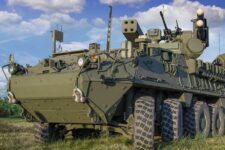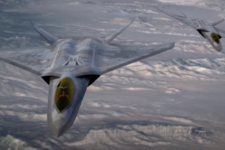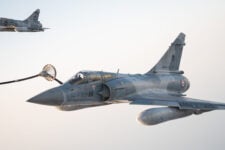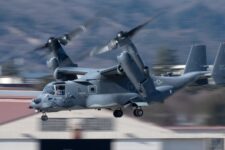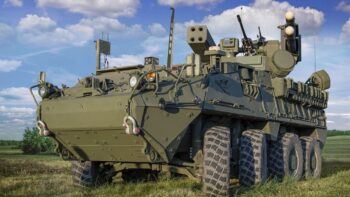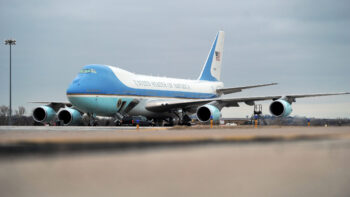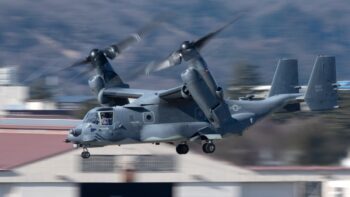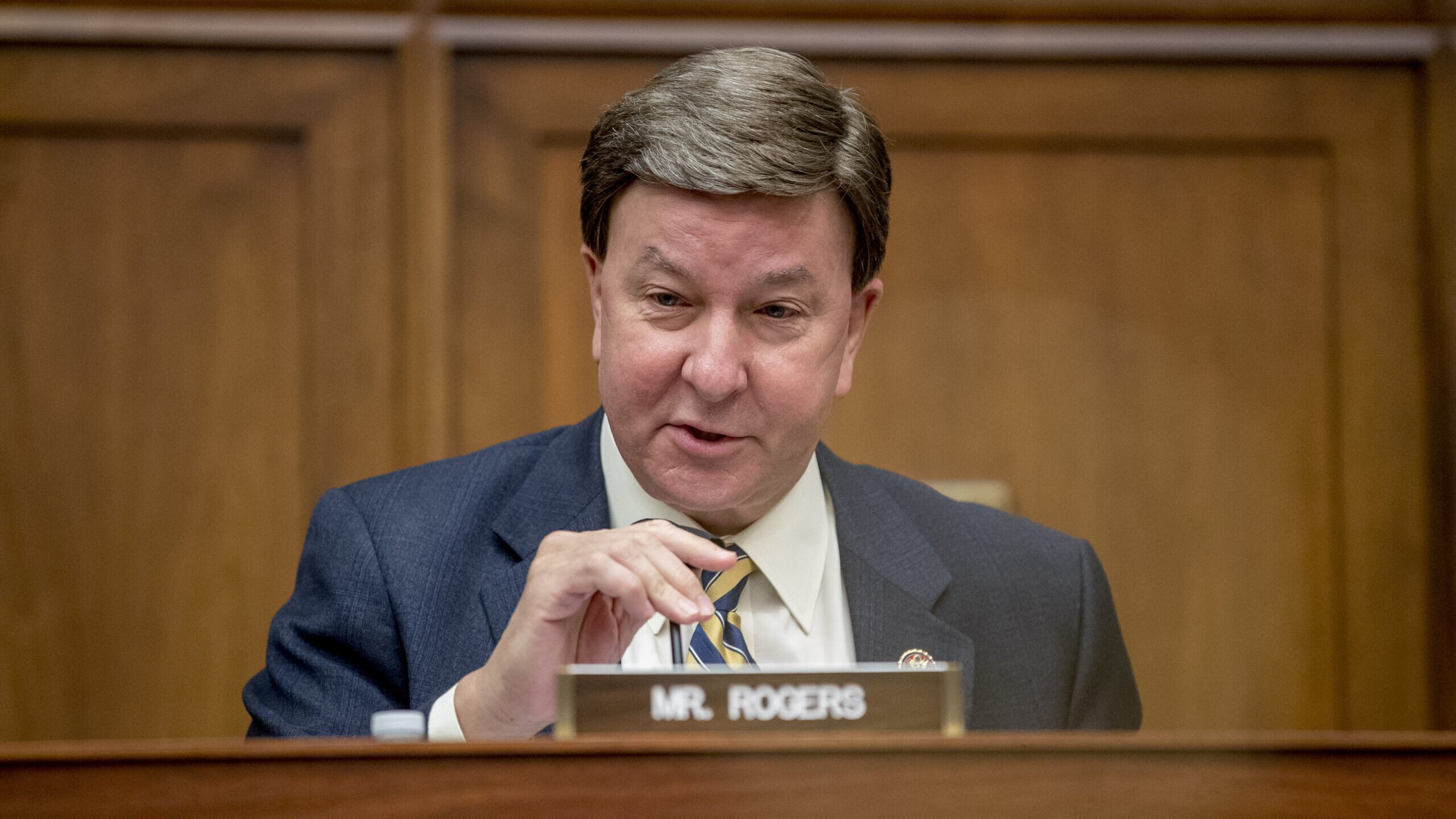
Rep. Mike Rogers, R-Ala., chairman of the House Armed Services Committee. (Credit: Andrew Harnik/AP Photo/Bloomberg via Getty Images)
WASHINGTON — The House Armed Services Committee (HASC) late Wednesday evening advanced its version of a key annual defense policy bill that abides by congressionally mandated budget caps but shifts billions in proposed funding for top programs like submarines and fighter jets.
House authorizers approved the draft $883.7 billion fiscal 2025 National Defense Authorization Act, including $849.8 billion for the Pentagon, in a near-unanimous 57-1 vote. The bill now heads to the full House, where all members of the lower chamber can vote on the legislation.
Authorizers’ dollar amounts are largely suggestions, as appropriators control the federal government’s purse strings. Still, the committee has purview over key policy fights. Many of the provisions approved today were previewed by the committee, such as an increase to the Navy’s submarine buy and cut to fighter jet procurement.
Throughout the marathon session that kicked off Wednesday morning and ended unusually early just after 10 pm, lawmakers frequently engaged in culture war battles. For example, the committee ultimately approved an amendment preventing considerations of minimizing climate change in acquisitions, while there were lengthy debates over measures like banning considerations of race in service academy appointments and military promotions.
Among the biggest news: The committee ultimately adopted an attenuated version of a proposal offered by the Air Force, which would reserve the right of state governors to approve the transfer of Guard units to the Space Force but stop short of creating a separate Space National Guard. That proposal had been among the most hotly debated topics in the NDAA, with all 50 state governors opposing the Air Force request.
According to HASC Chairman Mike Rogers, R-Ala., the committee prioritized resources for quality of life initiatives, like a major pay boost for junior enlisted servicemembers, which he noted is reflected in the legislation’s title.
“For the first time in decades, the bill before us today carries a different short title. It is the Service Member Quality of Life Improvement and National Defense Authorization Act. We did that to underscore the tremendous gains this bill makes toward improving the quality of life for all of our service members and their families,” he said.
“No service members should have to live in squalid conditions,” he continued. “No military family should have to rely on food stamps to feed their children. And no one serving this country should have to wait weeks to see a doctor or mental health specialist. This bill goes a long way toward fixing those problems.”
Once the House eventually passes the bill, the draft FY25 NDAA must be reconciled with the Senate’s version of the legislation. The Senate Armed Services Committee expects to start marking up its version of the legislation in June.
Still, it’s unclear how many of these moves may shake out until appropriators craft the FY25 budget. And if the FY24 budget process is any indication, that may take some time: Lawmakers only finally approved the FY24 budget in March, forcing the Pentagon to operate under a continuing resolution for the first half of the fiscal year.
Sea: Plus One Sub, Minus One Frigate
The committee quickly passed the seapower and projection forces section of the draft policy bill, which includes an extra $1 billion for the Navy to restore funding for a second Virginia-class submarine.
While funding the second sub itself is not controversial among most lawmakers, the House’s choice on where to cut funding to make room under the caps set by the Fiscal Responsibility Act of 2023 very well might be. The committee opted to gut the entirety of the Constellation class frigate’s $1.1 billion funding request, citing a “program delay.”
Navy Secretary Carlos Del Toro’s recent shipbuilding review found the new frigate program to be up to 36 months behind schedule. The Virginia-class program, which stands to directly benefit from the frigate’s cut, was found to be between two and three years delayed, depending on the block.
Although House authorizers approved the cut, it remains to be seen whether their Senate counterparts, as well as appropriators in both chambers, will follow suit. Coincidentally — or perhaps not — the lawmaker who would have been most likely to fight against Constellation’s budget being gutted is now former-Rep. Mike Gallagher, who represented the district of prime contractor Fincantieri Marinette Marine and resigned from his House seat earlier this year.
Elsewhere in the mark, lawmakers moved to extend the timeline for the congressionally-mandated commission on the future of the Navy. That panel was established in the Fiscal Year 2023 National Defense Authorization Act but failed to gain traction as congressional leadership dragged their feet on announcing panelist selections.
House lawmakers also moved to block the Navy from retiring two guided-missile cruisers as well as force the department’s leadership “to be consistent in the first 10-year planning window of the annual 30-year Shipbuilding Report to Congress.”
Through a package of en bloc amendments — typically non-controversial changes to the bill that majority and minority staffers have already agreed upon — House lawmakers passed a policy provision that would require the Navy to have 100 percent design completion prior to the start of construction on a lead ship. Completing design before construction begins is virtually unheard of for nearly all modern Navy shipbuilding programs.
Land: Army Drone Corps Moves Forward Despite Service Objection
One controversial item related to the Army made it into the draft legislation: a mandate for a drone corps.
That corps would include a chief, along with commissioned and non-commissioned officers, with primary responsibility over small- and medium-sized unmanned aerial systems (UAS that weigh less than 1,320 pounds) and counter-UAS (C-UAS). Those leaders would focus on integrating related systems inside the force, developing and testing out new systems, providing specialized training, and developing C-UAS strategies and capabilities.
However, Army leaders are pushing back and have said the new organization would be more hindrance than help.
“This is a capability that’s going to be, I think, resident in every formation at every echelon, so we see this as integrated into our formation, not some separate piece,” Army Chief of Staff Gen. Randy George told Senate appropriators on Tuesday. “I don’t think it would be helpful to have a separate drone branch,” he later added, noting that doing so would disrupt ongoing training and fielding plans.
Also on the drone front, the chairman’s mark notes that committee members are concerned about the Army’s retirement of the RQ-7 Shadow this year and a capability gap that divestment would create, since the fielding of the future tactical unmanned aerial systems (FTUAS) is years away.
“This gap may cause a disruption in the ability for the Army to provide a group 3 UAS capability over the next several years,” House authorizers wrote. “Additionally, the committee is concerned that the Army has failed to appropriately acquire and integrate tactical UAS at the necessary pace to keep up with the evolving landscape of warfare.”
To gather more insights on the plan, the draft bill directs the Army Secretary to brief lawmakers on the plan to bridge Group 3 UAS gaps and provide an evaluation of the Army’s efforts to acquire and integrate Group 1 and Group 2 UAS.
Air: Fewer F-35s, More F-15EXs And Greater Sentinel Oversight
The committee opted to slash 10 F-35s from the Pentagon’s requested 68, a $1 billion cut that lawmakers would direct back into the Joint Strike Fighter enterprise to resolve issues with the long-troubled program. Among the problems identified by committee staff are the stealth jet’s delayed Technology Refresh 3 upgrade, as well as issues identified by the Pentagon’s top weapons tester in a recent report.
Keeping with previous years, committee members would also reject a bid by the Air Force to scrap 32 older F-22 fighter jets, which the service argues would be too costly to make combat ready. The Air Force would similarly be barred from divesting any F-15E aircraft until the defense secretary delivers a report on how many fighter jets it thinks it needs. And, lawmakers appear poised to block at least some of the 16 KC-135 Stratotankers the Air Force wants to divest in FY25.
However, many of the Air Force’s 250 requested divestments would still be permitted, including 56 A-10 Warthogs. House authorizers would also add $271 million for advanced procurement of 24 F-15EXs, which would ultimately be acquired in FY26.
Additionally, amendments offered by California Democrat Rep. John Garamendi would require the Government Accountability Office to audit the DoD’s ongoing Nunn-McCurdy review of the Sentinel ICBM and ensure alternatives like life extensions for the Minuteman III fleet are fully evaluated. A similar amendment also adopted by the committee offered by Rep. Seth Moulton, D-Mass., would seek to maximize federal oversight of the program and opportunities for competition.
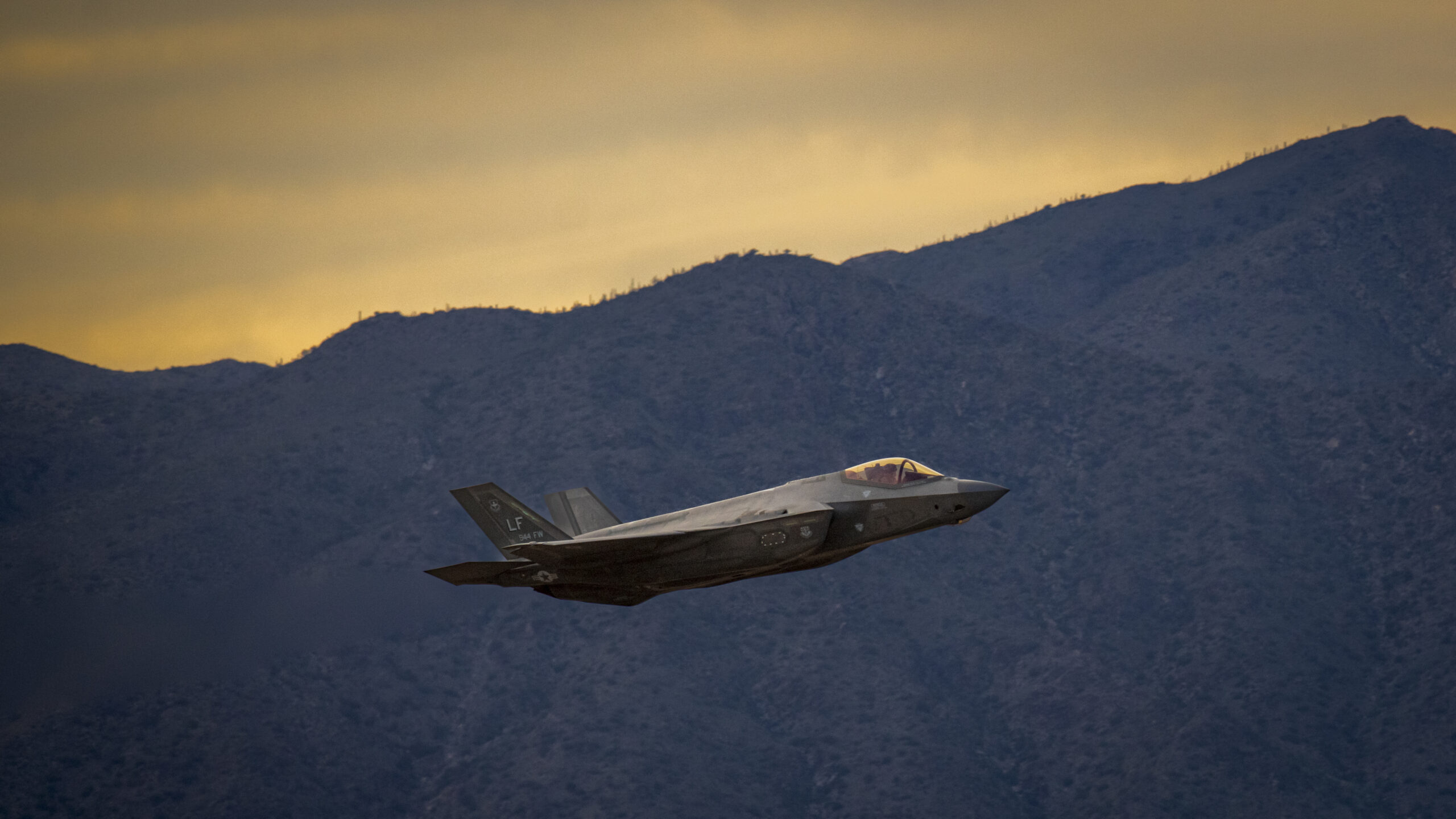
An F-35 Lightning II assigned to the 944th Fighter Wing, takes off from Luke Air Force Base, Arizona, Nov. 15, 2022. (U.S. Air Force photo by Senior Airman Noah D. Coger)
Space: Putting Poor Contractor Performance on Watch
While the biggest space-related fight was over the National Guard question, there were other issues also in play.
In accordance with the HASC chair’s draft language, the committee adopted language that would empower Air Force space acquisition czar Frank Calvelli, rather than the Space Force’s Space System Command (SSC), with the power to sanction and/or blacklist underperforming contractors. Up to now, SSC has never publicly admitted to using the Contractor Responsibility Watch List (CRWL) created by the FY18 NDAA, despite Calvelli’s urging and his naming and shaming of failing programs, including the GPS Next Generation Operational Control System (OCX) under development by RTX. The HASC move follows Calvelli’s May 1 testimony that he would welcome elevation of CRWL authority to his office.
Rep. Doug Lamborn, R-Colo., chair of HASC’s strategic forces subcommittee, also welcomed the draft NDAA “provisions in this mark that ask the Space Force to continue to budget and plan for the integration of cutting-edge commercial systems.” These provisions include the committee’s stamp of approval on the Space Force’s plan to create a “Commercial Augmentation Space Reserve” program that would compensate commercial space firms promising to support the US military in wartime for damages if attacked.
Finally, an amendment offered by Rep. Pat Fallon, R-Texas, was passed that requires Chief of Space Operations Gen. Chance Saltzman to submit a comprehensive plan to modernize the Space Force’s woefully outdated Satellite Control Network that manages day-to-day operations of many service satellites.
DoD Wide: Replicator Clarity
When lawmakers approved the chairman’s mark, they signed off on a provision calling for more clarity over the Department of Defense’s Replicator program. The semi-secretive initiative is billed as one way to counter China’s military mass by cranking out multiple thousands of “attritable autonomous systems” within two years — think unmanned surface vessels and loitering drones.
While the draft NDAA doesn’t call Replicator out by name, it notes that the term “attritable unmanned aircraft system (UAS) remains ambiguous” and House defense authorizers want more information.
“The committee recognizes that categorizing UAS as expendable or attritable varies with the situation. Additionally, the committee acknowledges the difficulty of classifying UAS into weight-based categories as expendable or attritable, considering the different sensor and munition configurations they can carry,” the bill says. “However, the committee believes there is still utility in illuminating how the Department of Defense views and categorizes its UAS as attritable.”
If the House provision is ultimately signed into law, DoD officials would be required to brief lawmakers by Dec. 1 on what “attritable” means, how the Department categorizes those systems, and what the per-unit dollar amount is attached to Groups 1 through 5 UAS.
